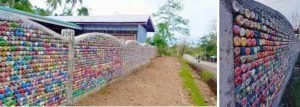
The strongest governments on earth cannot clean up pollution by themselves. They must rely on each ordinary person, like you and me, on our choices, and on our will.” — Chai Jing, journalist & environmental activist.
Supportive to this goal of preserving and caring for the environment, the Department of Social Welfare and Development (DSWD) as a member of the Cabinet Cluster on Climate Change Adaptation, Mitigation, and Disaster Risk Reduction (CCAM-DRR), implements the Risk Resiliency Program- Climate Change Adaptation and Mitigation- Disaster Risk Reduction or RRP-CCAM-DRR.
The RRP is aimed at strengthening the resiliency of the natural ecosystems and the adaptive capacity of the vulnerable groups and communities to short and long term risks. Projects and activities are conducted through the Cash-for-Work (CFW) modality which provides short-term intervention and temporary income opportunities to economically-vulnerable segments of the population in exchange for community works rendered related to climate change adaptation, and disaster mitigation.
The DSWD through its RRP supports initiatives being implemented in different municipalities along Plastic Bottles Recycling, Mangrove Reforestation, Urban Gardening, Riverbanks Rehabilitation, among others.
Plastic bottles turn walls
In Caraga, “unexpected outcome,” were the first words uttered by Jude Limbaro, the Municipal Social Welfare and Development Officer (MSWDO) of the local government unit (LGU) of Bayabas, Surigao del Sur, when asked about the outcome of their RRP-CCAM-DRR plastic bottle recycling project in 2021.
The innovative project was the LGU’s Recycling Project implemented under the RRP-CCAM-DRR through the CFW modality of the DSWD. With the locals full cooperation, they were able to produce 20,000 eco-bricks in 10 days from the plastic wastes they collected. The end product is an eco-brick wall which is a colorful wall made of plastic-bottle bricks. The colorful brick wall captured the attention of a passer-by who uploaded a video of the project on social media.
Consequently, in early January 2022, local netizens got excited about the aesthetic fence of a vermi-bed facility along the national highway of Cantilan-Tandag Road. The project amazed those who have seen the ingenuity of making colorful walls out of plastic bottles with colored cellophanes.
Creating recycled beauty
“(This is part of) our goal to reduce solid wastes and be part of the mitigation and adaptation initiatives of the government against the climate change problems. The said project is among the different RRP-CCAM-DRR implemented by the LGU, together with the Mangrove Reforestation (Sagip-Wakatan), Kawayanihan (Sagip-ilog), Guavayanihan (Sagip-tubig), and Gulayan-Bayanihan,” LGU Bayabas Mayor Maria Clarita Limbaro proudly posted on her social media, expressing fulfilment of the initiatives of LGU Bayabas.
It may have started out as an LGU plan, but the result was through the efforts of the residents wanting to partake in helping the environment and becoming advocates for climate change resiliency.
MSWDO Limbaro underscored that the success of the project should be rightfully merited to the hardworking people of Bayabas. He also noted that this battle against plastic bottles is not exclusive to coastal communities but a universal one.
“Kini nga kalampusan naghatag sa mga beneficiaries ug dugang kadasig nga muapil sa mga sumusunod pa nga proyekto sa gobyerno batok sa environmental degradation.” (The success of this project inspires the beneficiaries to be involved again in future government projects to combat environmental degradation), MSWDO Limbaro added.
The DSWD re-echoes what the head of Bayabas Social Welfare and Development Office has said, emphasizing that program beneficiaries are not just passive recipients of government assistance but they can also be active participants of development efforts. ###


